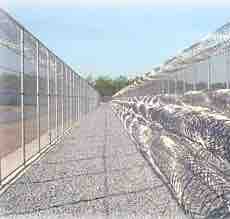A prison is a place in which people are physically confined and, usually, deprived of a range of personal freedoms. Imprisonment is a legal penalty that may be imposed by the state for the commission of a crime. For most of history, imprisoning has not been a punishment in itself, but rather a way to confine criminals until corporal or capital punishment was administered. Only in the 19th century, beginning in Britain, did prisons as they are known today become commonplace. The modern prison system was born in London, influenced by the utilitarianism of Jeremy Bentham.
Prison Design
Prisons are normally surrounded by fencing, walls, earthworks, geographical features, or other barriers to prevent escape. Multiple barriers, concertina wire, electrified fencing, secured and defensible main gates, armed guard towers, lighting, motion sensors, dogs and roving patrols may all also be present, depending on the level of security.

Prison
Barbed wire is a feature of prisons.
Modern prison designs have sought to increasingly restrict and control the movement of prisoners throughout the facility, while permitting a maximal degree of direct monitoring by a smaller prison staff. As compared to traditional large landing-cellblock designs, which were inherited from the 19th century and which permitted only intermittent observation of prisoners, many newer prisons are designed in a decentralized "popular" layout.
Incarceration in the United States
In the United States, "jail" and "prison" refer to separate levels of incarceration; generally speaking, jails are county or city administrated institutions which house both inmates awaiting trial on the local level, and convicted misdemeanants serving a term of one year or less, while prisons are state or federal facilities housing convicted felons serving a term of more than one year. Supermax prisons provide long term, segregated housing for inmates classified as the highest security risks in the prison system—the "worst of the worst" criminals, and those who pose a threat to national and international security.
The United States has the highest documented incarceration rate in the world (743 per 100,000 population). Incarceration rate in the U.S. for federal and state prisons in 2007 was the highest in history of the country. It was 5.5 times greater than the sharp peak that occurred during the Great Depression at 137 per 100,000 in 1939. According to the U.S. Bureau of Justice Statistics (BJS), 2,266,800 adults were incarcerated in U.S. count jails and federal and state prisons at yearend 2010; this represents about 0.7% of adults in the U.S. resident population. Additionally, 4,933,667 adults at yearend 2009 were on probation or on parole. In total, 7,225,800 adults were under correctional supervision (probation, parole, jail, or prison) in 2009, representing about 3.1% of adults in the U.S. resident population.
According to the U.S. Bureau of Justice Statistics (BJS), non-Hispanic blacks accounted for 39.4% of the total prison and jail population in 2009. According to the 2010 census of the U.S. Census Bureau, blacks (including Hispanic blacks) comprised 13.6% of the US population. Hispanics (of all races) were 20.6% of the total jail and prison population in 2009. Hispanics comprised 16.3% of the U.S. population according to the 2010 U.S. census.